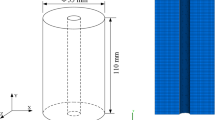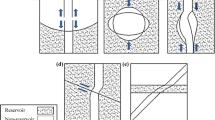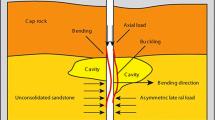Abstract
Salt domes are considered as one of the most important oil traps. Drilling in salt regions is associated with many problems. Challenging problems in drilling include trapping of the drill pipe string and reducing diameter of the wellbore. Convergence of wellbore’s wall in rock salts is mainly attributable to creep phenomenon. Tests on thick-walled hollow cylinder are one relative easy, economical, and realistic means to better understand the behavior of underground openings. In this research, hollow cylinder was used for modeling wellbore. Triaxial creep tests on thick-walled hollow cylindrical rock salt specimens were conducted. The effect of confining pressure, deviator stress, and strain rate on creep behavior of rock salt was studied. The results revealed that strain rate increases by increasing the deviatoric stress and confining pressure. The importance of lateral pressure was more of deviatoric stress in variations tangential strain rate. Furthermore, a mathematical equation was developed to estimate the strain rate in various stress fields. The experimental data of this research is served in another ongoing research for modeling, using a numerical modeling technique.















Similar content being viewed by others
References
ASTM D2938 (2006) Standard test method for unconfined compressive strength of intact rock core samples, Annual Book of ASTM Standards
Agergaard FA ( 2009) Modeling of rock salt creep. Master Thesis
Bérest P, Karimi-Jafari M, Brouard B (2005) Transient creep in salt caverns, In: Proceedings of 2005 Joint ASME/ASCE/SES Conference on Mechanics and Materials, Louisiana, USA
Cristescu ND, Hunsche U (1996) A comprehensive constitutive equation for rock salt determination and application’, In Proceedings of the 3th Conference on the Mechanical Behavior of Salt (pp. 191–205), Clausthal-Zellerfeld: Trans Tech Publications
Cristescu ND, Hunsche U (1998) Time effects in rock mechanics. John Wiley & Sons Ltd., West Sussex
Cleach JM, Land Ghazali A, Deveughele H, Brulhet J (1996) Experimental study of the role of humidity on the thermomechanical behavior of various halitic rocks. In Proceedings of the Third Conference on the Mechanical Behavior of Salt (pp. 231–236). Clausthal-Zellerfeld: Trans Tech Publications
Farmer P, Miller D (1996) Exploring the subsalt, p.p. 53–55
Farmer W, Gilbert MJ (1984) Time dependent strength reduction of rock salt. In: Proceedings of the First Conference on the Mechanical Behaviour of Salt (pp. 3–18). Clausthal-Zellerfeld: Trans Tech Publications
Franssen RCM, Spiers C J (1990) Deformation of polycrystalline salt in compression and in shear at 250-350°C. Deformation Mechanisms, Rheology and Tectonics, Geological Society Special Publication. 45: 201–213
Goodman RE (1989) Introduction to rock mechanics, 2nd edn. JohnWhiely and sons publication
Hosseini SMA (2012) Development of a new creep testing equipment to obtain long-term deformation parameters of salt. J Min Environ 3:27–32
Hunsche U, (1994) Uniaxial and triaxial creep and failure test on rock, experiment technique and interpretation. In: Cristecu NS (ed) Viscoplastic Behavior of Geomaterial, Springer-Verlag
Jeremic ML (1994) Rock mechanics in salt mining. A.A. Balkema Publishers, Netherland, p 517, 9054101032
Munson DE ( 1979) Constitutive modeling of salt behavior state of the technology’. In: Proceedings of 7th International Congress on Rock Mechanics, p. 1979–1810
Singh DP (1975) A study of creep of rocks, International Journal of Rock Mechanics, Mining Science and Geomechanic Abstracts (Pergamon Press) Vol. 12: 271–276
Tarbuk AG, Lotgen FK (2003), Principles of geology, School Publishing
Wawersik WR, Morgan liS (1989) Computed and measured responses of thickwalled hollow cylinder of salt subjected to both homogeneous and inltomogeneous loading٫ ,Pro_. 30th U. S. Syrup. Rock Mech., p. 361.368. Rotterdam: Balkema
Wawersik et al (1991) Engineering and structure mechanic division, 7th International congress on Rock Mechanics
Wawersik WR (1981) Creep testing of salt: procedures, problem and suggestions. In: The First Conference on Mechanical Behaviors of Salt, Trans Tech Publication. p. 421±49
Yang C, Yin J (1999) Experimental investigation of creep behavior of salt rock. Int J Rock Mech Min Sci 36:233–242
Acknowledgments
This research was conducted in cooperation with the National Company of South-rich areas. The authors are thankful for this cooperation.
Author information
Authors and Affiliations
Corresponding author
Rights and permissions
About this article
Cite this article
Rahimi, S., Hosseini, M. Laboratory studies of creep behavior on thick-walled hollow cylindrical salt rock specimens. Arab J Geosci 8, 5949–5957 (2015). https://doi.org/10.1007/s12517-014-1622-5
Received:
Accepted:
Published:
Issue Date:
DOI: https://doi.org/10.1007/s12517-014-1622-5




